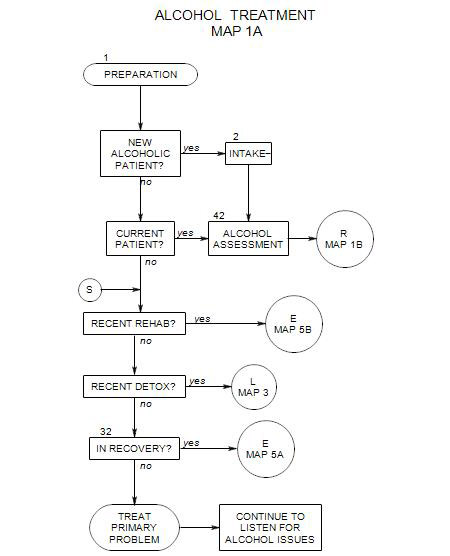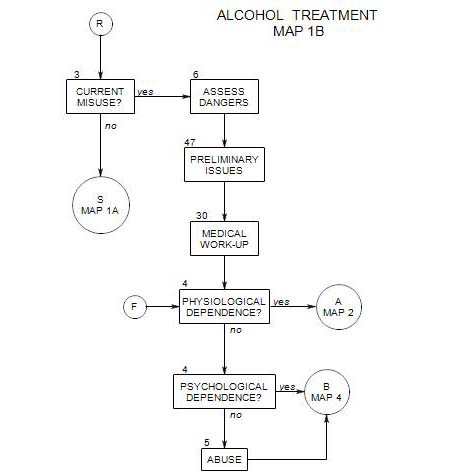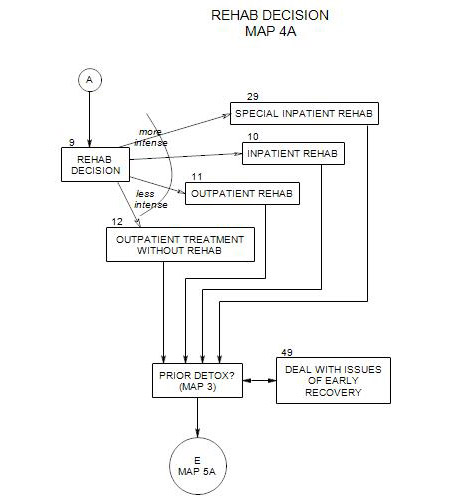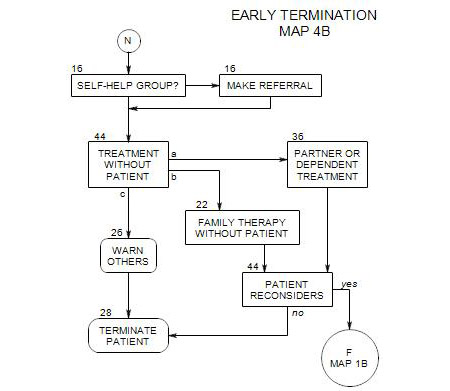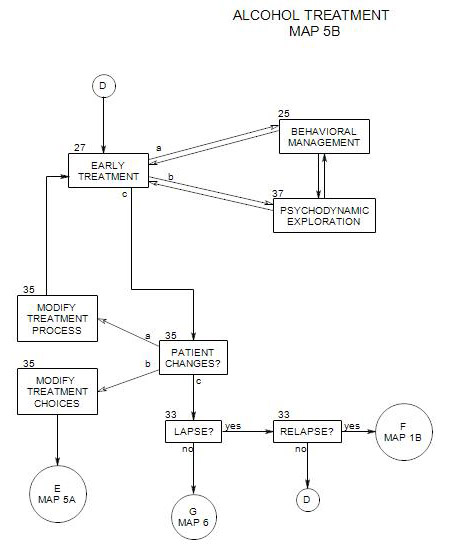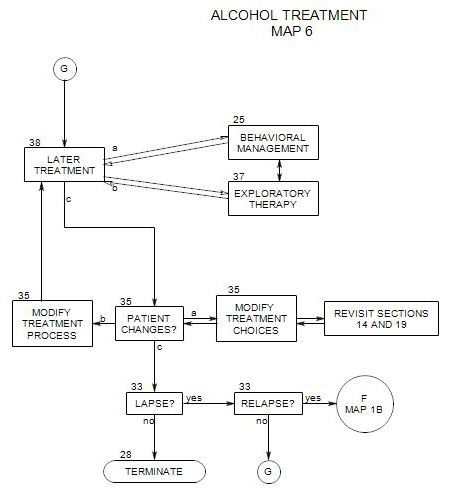This section coordinates with Section 2 [Intake]. Which takes more of an overview of the intake session, and with Section 27. [Ongoing Psychotherapy] where many of the same issues are addressed again, more extensively.
The following are suggestions for you to pick from, depending on your patient’s presentation and apparent involvement with alcohol. At the stage of the initial assessment, you may not have a clue as to where the interview will lead, so it’s best to have a range of directions ready to pursue. As indicated in Section 2, it is possible that a patient will come to treatment for alcohol or alcohol-related issues. In that case, there is less need for the present section.
If you miss something – and the person continues to come to see you – you can always gather more information the second session, or at any time later on.
strong>42a. Physical Cues About Alcohol Misuse
If a person has been drinking heavily, you may sense something wrong with his/her presentation, without necessarily being able to say what it is. Below are some possibilities that may help you define the problem more clearly.
PRESENT INTOXICATION
Is there any obvious smell of alcohol on or around the person? Alcohol is eliminated through the urine, the lungs, and the skin. If a person has been drinking that day or the day before, it is possible that you will smell it. If a person is drinking every day, alcohol will be emitted significantly through the skin and lungs.If the person is disoriented or slurring words, that can be another sign of intoxication.
SOBER FOR THE INTERVIEW
Is there any obvious shaking? A tremor could be a sign of mild DT’s [delirium tremens, a physiological reaction to alcohol withdrawal], especially if the person is a regular drinker who didn’t drink in anticipation of the interview. Usually withdrawal starts between 36 and 48 hours after the last drink.
ACTIVE ALCOHOLIC
There are a few physical symptoms of an active alcoholic that you can look for. If you see them, the person is a heavy user and likely physiologically dependent. These include
- bloodshot or watery eyes: the eyes don’t look healthy.
- an unhealthy color to the skin: pale, gray.
- a dazed appearance.
- a report that he/she had a rough night and didn’t get much sleep. You can wonder what caused the rough night, and possibly explore it then, or save it for later.
SUBSTANTIAL, LONG-TERM DAMAGE
When the person has been abusive of or dependent on alcohol over long time, there can be signs of physical damage:
- Shaking could be a sign of advanced alcohol dependence.
- In later stages, yellow skin [jaundice] can be a sign of liver damage.
- Spider veins on the nose, where the nose becomes bulbous and discolored because of broken capillaries.
- A slight problem walking: one possible consequence of drinking is gout, including a swelling of the feet, which is very painful.
42b. Other Possible Physical Symptoms of Misuse
Some physical consequence of alcohol misuse may be detected in a medical examination, especially if the appropriate tests are done [See Section 30 ]. Most of what you are likely to find in a therapy session are indirect, soft signs that need further examination. These may include
- complaints of poor coordination or inability to concentrate.
- difficulty sleeping.
- sexual dysfunction or lack of sexual interest.
- blackouts, which may be reported as puzzling behavior that the patient wants to understand.
- ineffectiveness of standard medications or unusual side effects, which may be consequences of interactions with alcohol in the person’s system.
42c. Medical Conditions as Possible Reasons for Drinking:
Drinking is one way that some people manage pain, whether it be episodic or chronic, and in some cases it can be an effective analgesic.
However alcohol can also worsen medical conditions, hide serious medical issues, and compound with some disorders to cause dangerous complications. In some cases, as with diabetes and hypertension, it can be lethal. The two disorders may also be unrelated: a person may be a heavy drinker and also have a medical condition. The results are the same: we have to be concerned about interactions between the person’s alcohol use and either his/her other medical condition or the treatments used to manage it.
Alcohol interacts with many prescription drugs, either to amplify or reduce their effects. The interaction is unpredictable, depending in part on the amount the person drinks.
It is important to get lists, to update them regularly, and to compare them for possible dangers:
- All physical disabilities and other medical conditions the person has.
- All medications the person uses, amounts, and frequencies.
- How much the person drinks, how frequently, on what occasions, etc.
If there are any likely complications here, then you should be in regular contact with the person’s physician about the issues and what can be done to reduce risks and improve treatment effectiveness.
If the person appears to be misusing alcohol [ Section 3 ], then a medical workup is a standard part of the intake process. However, depending on findings at this point, it might also be an important recommendation for patients who don’t appear to be misusing alcohol as well.
42d. Psychological and Interpersonal Symptoms Could Suggest Misuse
A wide range of psychological and interpersonal issues could be indicative of alcohol misuse. Unfortunately, the diagnostic picture often isn’t clear, because they could also have other causes, including the patient’s family structure, neighborhood, working conditions, or other primary psychological disorders.
- A patient’s complaints of chronic fatigue and lack of motivation may be related to chronic drinking.
- Alcohol can be a disinhibitor. Drinking too much can lead to a variety of impulsive or reckless behaviors – excessive gambling, reckless driving, operating equipment in a dangerous way, hypersexuality, provocative encounters with others, unprotected sex with strangers, etc.
- Drinking may operate in conjunction with other defenses, as when a person withdraws from an argument with a family member, drinks, and goes to bed or falls asleep in the living room. Here a spouse’s complaint might simply be that he/she won’t ever finish an argument; or the drinking might be mentioned as the primary issue.
- Evidence of excessive drinking may be imbedded in complaints about others. A man may complain that his wife nags him to do chores around the house all weekend. Further questioning may reveal that he sleeps all day Saturday because he is hung over from getting drunk Friday nights.
42e. Amounts and Frequency of Use
It is generally a good idea to ask how much the person drinks, and the information can be helpful. However, you should remain skeptical about the accuracy of the report. For many reasons, people tend to understate their drinking. Following are some questions you could ask:
- How often do you drink? Do you drink every day? If not, are there days you typically drink and days you don’t?
- How much do you drink on an average day? Is it different for weekends?
- What’s the longest you have gone without drinking in the past three months? How long could you go comfortably?
- What was your biggest drinking day in the past three months?
- Do you have regular drinking occasions? [Possibilities could include watching sports programs, like Monday Night Football, or having a regular get-together, like Wednesday Lunch with the Ladies.] How much do you typically drink on these occasions?
- How much do you typically drink at large social events, like weddings or other parties?
- Do you see a pattern to your drinking?
42f. Family Alcohol Involvement
It can be helpful to find out about the drug and alcohol use of other people in the person’s current, childhood and extended families. This line of questioning can have several benefits. First, it can raise issues of substance use in an indirect way – by talking about others, the person is not self-revealing a lot so early in the therapy. However, in the process the person may reveal a lot about his/her attitudes toward drinking and the family members who drink. At the same time, the attitudes of the family may become clear. Those attitudes – depending on the person’s involvements with the associated family members – can affect the overall context of alcohol use for the person. Also, if the person will need to face a drinking issue, it is helpful to know which current family members are likely to be supportive of the work which ones might interfere with it.
42g. Information About the Patient from Others
In any psychotherapy intake process, it can often be useful to meet at least once with the patient’s partner, and possibly other family members, to get a fully rounded picture of the patient and his/her issues. Often such interviews lead to information that the patient would not mention. The information may include direct complaints about the patient’s drinking behavior, or it may include complaints or observations about any of the issues above.
One way to get others in is to tell the patient that it is standard procedure when starting psychotherapy – and it may be for you – and gather information about other members of the patient’s immediate family, including contact information. Then either the patient or therapist can invite a partner, or possibly the entire family, in for a session.
Information from a couple, partner or family session can be useful in many ways. It can –
- give information about the patient relative to alcohol use and many other aspects of his/her life, information he/she might otherwise be reluctant to share or not think helpful.
- give information about other family members, who constitute the context for much of the patient’s life and drinking behavior.
- be a good resource to family history.
- open the door to subsequent sessions with others or the family as a whole. Once others have met the therapist, contact with them can become part of the therapeutic process. Couple, partner or family work may eventually become part of treatment. The seeds of future opportunity can be cast at this point.
42h. Your Attitude Toward the Patient
The consensus of professionals regarding the best posture when dealing with someone whom you suspect misuses alcohol is “empathic skepticism”: you can be sympathetic to the person’s plight but question the content of the patient’s reports. It is part of an alcoholic’s defenses that he/she doesn’t tell the truth, minimizes, and wants you to believe that he/she is doing well. Guilt and shame, as well as fear of alcohol deprivation upon discovery are primary motivators for denial.
Any confronting needs to be caring and gentle but persistent, so as to challenge defenses while engaging the patient in the treatment process. These issues are discussed in Section 2 and Section 24.
42i. Other Information
Gather information on any psychological symptoms that the patient may be concerned about. Ask about the history of each – when it started, attempts to treat it, how it changed over time. Also gather information on the person’s drinking history: when it started, how it has changed over time, and what the current effects are.
Note especially whether there seems to be a connection between the patient’s drinking history and the history of his/her other symptoms or disorders. Alcohol could be a source of the patient’s other symptoms, it could exacerbate them, or it could be used as an attempt to medicate them.
Make special note of a person with early onset alcoholism – someone who developed a serious drinking problem before the age of 25, who also has a family history of alcoholism. Such a person is more likely to have a biological disposition to alcohol misuse, and a more severe and stable drinking disorder.
42j. Formal Assessment Instruments
If you like structured assessment interviews or questionnaires, a large number are available for use. Some are listed or reproduced in Epstein & McCrady (2009a: 41-48, 219-228) and Perkinson (2002: Appendices 1-4). A free, online instrument and associated manual can be obtained from the World Health Organization. Look under Publications and type in “Alcohol Use Disorders Identification Test”.
These interviews have an advantage of being comprehensive and broadly applicable. However, they often include information irrelevant to a particular patient, they are time consuming, they are far less personal than unstructured clinical sessions, and there is little reason to believe that patients will be more honest and open on paper than in person.
